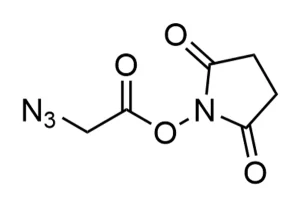Azido-dPEG®4-acid, product number QBD-10502, is a click chemistry crosslinking reagent. The azide moiety on one end of the molecule is useful for copper(I)- or ruthenium-catalyzed click chemistry or copper-free click chemistry. Between the azide moiety and the propanoic acid moiety on the other end of the molecule is a single molecular weight, discrete polyethylene glycol (dPEG®) spacer. The propanoic acid moiety can be coupled to a primary or secondary amine by an acylation reaction. The azide also functions as a masked amine. In this application, the carboxylic acid end reacts first with an amine to form a peptide bond, followed by reduction of the azide to an amine for further reaction.
Activation of the propanoic acid moiety with an acylating agent enables conjugation of azido-dPEG®4-acid to a primary or secondary amine. Popular acylating agents include such as N-hydroxysuccinimide (NHS); 2,3,5,6-tetrafluorophenol (TFP); or 2,3,4,5,6-pentafluorophenol (PFP). Alternatively, 1-Ethyl-3-(3-dimethylaminopropyl) carbodiimide (EDC) or another suitable carbodiimide can be used to couple the acid moiety directly to an amine without prior activation.
| Unit Size | 100 mg, 1000 mg |
|---|---|
| Molecular Weight | 291.30; single compound |
| Chemical formula | C₁₁H₂₁N₃O₆ |
| CAS | 1257063-35-6 |
| Purity | > 98% |
| Spacers | dPEG® Spacer is 16 atoms and 17.7 Å |
| Shipping | Ambient |
| Typical solubility properties (for additional information contact Customer Support) | Methylene chloride, Acetonitrile, DMAC or DMSO. |
| Storage and handling | -20°C; Always let come to room temperature before opening; be careful to limit exposure to moisture and restore under an inert atmosphere; stock solutions can be prepared with dry solvent and kept for several days (freeze when not in use). dPEG® pegylation compounds are generally hygroscopic and should be treated as such. This will be less noticeable with liquids, but the solids will become tacky and difficult to manipulate, if care is not taken to minimize air exposure. |
Greg T. Hermanson, Bioconjugate Techniques, 3rd Edition, Elsevier, Waltham, MA 02451, 2013, ISBN 978-0-12-382239-0; See Chapter 18, Discrete PEG Reagents, pp. 787-821, for a full overview of the dPEG® products.
Click Chemistry on Solution-Dispersed Graphene and Monolayer CVD Graphene. Zhong Jin, Thomas P. McNicholas, Chih-Jen Shih, Qing Hua Wang, Geraldine L. C. Paulus, Andrew J. Hilmer, Steven Shimizu and Michael S. Strano. Chemistry of Materials. 2011, 23(1) pp 3362-3370. June 30, 2011. DOI: 10.1021/cm201131v.
“Click” Immobilization of a VEGF-Mimetic Peptide on Decellularized Endothelial Extracellular Matrix to Enhance Angiogenesis. Lin Wang, Meirong Zhao, Siheng Li, Uriel J. Erasquin, Hao Wang, Li Ren, Changyi Chen, Yingjun Wang, and Chengzhi Cai. ACS Applied Materials and Interfaces. 2014, 6(11) pp 8401-8406. April 21, 2014. DOI: 10.1021/am501309d.
The carbohydrate-linked phosphorylcholine of the parasitic nematode product ES-62 modulates complement activation. Umul Kulthum Ahmed, N. Claire Maller, Asif J. Iqbal, Lamyaa Al-Riyami, William Harnett, and John G. Raynes. The Journal of Biological Chemistry. 2016, April 4, 2016. DOI: 10.1074/jbc.M115.702746.
Biomolecular Strategies for Cell Surface Engineering. John Tanner Wilson. Doctoral Dissertation, Georgia Institute of Technology: Atlanta, Georgia USA, 2009.
Multistage signal-interactive nanoparticles improve tumor targeting through efficient nanoparticle-cell communications. Feng Zhang, Yiran Zhang, Li Kong, Huanhuan Luo, Yuezhou Zhang, Ermei Mäkilä, Jarno Salonen, Jouni T.Hirvonen, Yueqi Zhu, Yingsheng Cheng, Lianfu Deng, Hongbo Zhang, Alexander Kros, Wenguo Cui, Hélder A.Santos.Cell Reports. 2021, Volume 35, Issue 8. 05/25/2021. DOI: 10.1016/j.celrep.2021.109131
Applicable patents and legal notices are available at legal notices.




Stay in the Loop. Join Our Online Community
Products
Ordering
About Us
Application
Resources

©Vector Laboratories, Inc. 2025 All Rights Reserved.
To provide the best experiences, we use technologies like cookies to store and/or access device information. Consenting to these technologies will allow us to process data such as browsing behavior or unique IDs on this site. Not consenting or withdrawing consent, may adversely affect certain features and functions. Privacy Statement
How do I Request a Quote?
To request a quote for products: